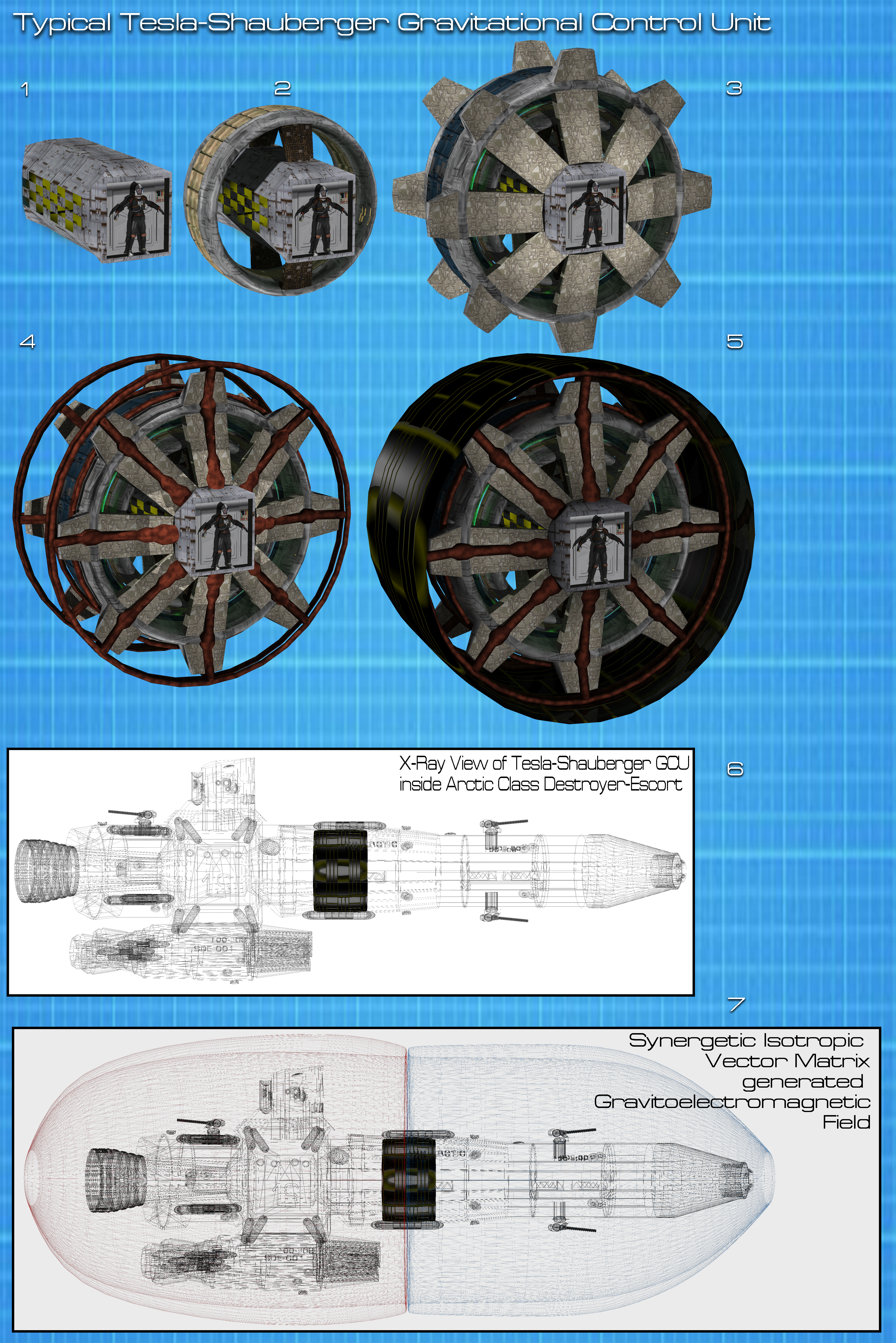 |
Tesla Schauberger Gravitational Control Unit:
The discovery of the L4-2035 alien derelict near the LaGrange colonies in the year 2035 brought with it a whole new view into what was possible. The physics of the alien ship were daunting, but not impossible to understand. One of the revelations of the discovery of the L4-3025 object was that neither the Gravity model, nor the Electric model of the universe was complete. Both had portions which were correct and both had serious flaws. The largest flaw in both theories was that the universe had to be one or the other, yet what the alien ship proved was that the universe was in fact both. Meaning it was a Gravito-Electric construct that favored synergistic forms, and was not in fact a result of chaos. From the epiphany that came with the technology of the L4-2035 object, a new discipline of physics began: Super-Dimensional Energy physics. Within the confines of this discipline it was determined that gravitons do not exist in three-dimensions alone. In fact, it was postulated that gravitons generated gravity (as we know it) due to torsion-vorticies generated using electromagnetic fields that create a plasma (much like the aurora borealis) as they passed through 3D space from higher dimensions. It was through a better understanding of how synergetics--as postulated by Buckminster Fuller--could be applied to actual technology that the first gravitational control units came into being. These primitive devices used a physical Isotropic-Vector Matrix device that generated an Gravitoelectromagnetic field by using electromagnetic sections (usually "strips") at key sections along a ship's hull (this was the method used on the Solar Empire's Ironclads like the Petya class Destroyer-escort). A more efficient system was created by applying Tesla's power distribution theories (wireless, high-voltage, high frequency), with Viktor Shauberger's theories on vortex power. By using the theories of both men, and the alien gravitational control unit as a guide, the scientists of the LaGrange Colonies, and the United States Space Navy were able to produce the first compact GCU (Gravitational Control Unit), the Tesla-Shauberger GCU. The device is rather simple in overall design, but its systems are quite complex.
1) The control room for the GCU is located at the center of the device, and is a "null" gravity zone where no gravity exists due to the negative gravity effect of the generator.
2) The inner or positive charge ring that creates the forward facing bowl shaped "primer field".
3) The outer or negative charge ring that creates the rearward facing bowl shaped "primer field".
4) The main power conduits used to evenly distribute the emission of the Gravitoelectromagnetic field to the graviton belt on the outer hull of the ship.
5) The completed unit with the insulator shell around it to protect the hull from the ultra-high voltage generated by the GCU.
6) X-ray view showing the location of the GCU in an Earth Federal Republic Space Navy Arctic class destroyer-escort.
7) The synergetic isotropic vector matrix generated gravitoelectromagnetic field created by the Tesla-Shauberger GCU. By using an electromagnetic field, rather than electromagnetically charged metallic plates, the efficiency of the field is far greater. Note that you can see the outer field (the repulsor force) and the inner field (attractive force) as they are formed close to each other. The outer field is used much in the same way as that of the Earth's electromagnetic field in that it protects against cosmic radiation, however, the field is also strong enough to deflect micro-meteors and other small objects that could pose a threat to the ship at sublight velocities. The inner field generates the ship's internal gravity and acts as the inertia dampening system that protects the crew from being crushed at high speeds or during high-speed maneuvers. The combined fields act as a small planetary body in that they repel the ship (when tuned to the right gravitonic charge) from the surface of a planet. While this cannot propel a ship like an engine, it does allow a vessel like the Arctic class to not have to expend enormous amounts of energy trying to break away from a planet's gravity (like conventional rockets have to do with Earth). It should be noted that the mass of the ship does play a role in effecting the generation of these fields. As illustrated here, the fields are not centered on the GCU, they are slightly to the rear due to the fact that the majority of the Arctic class ship's mass is to the rear of the generator.
|
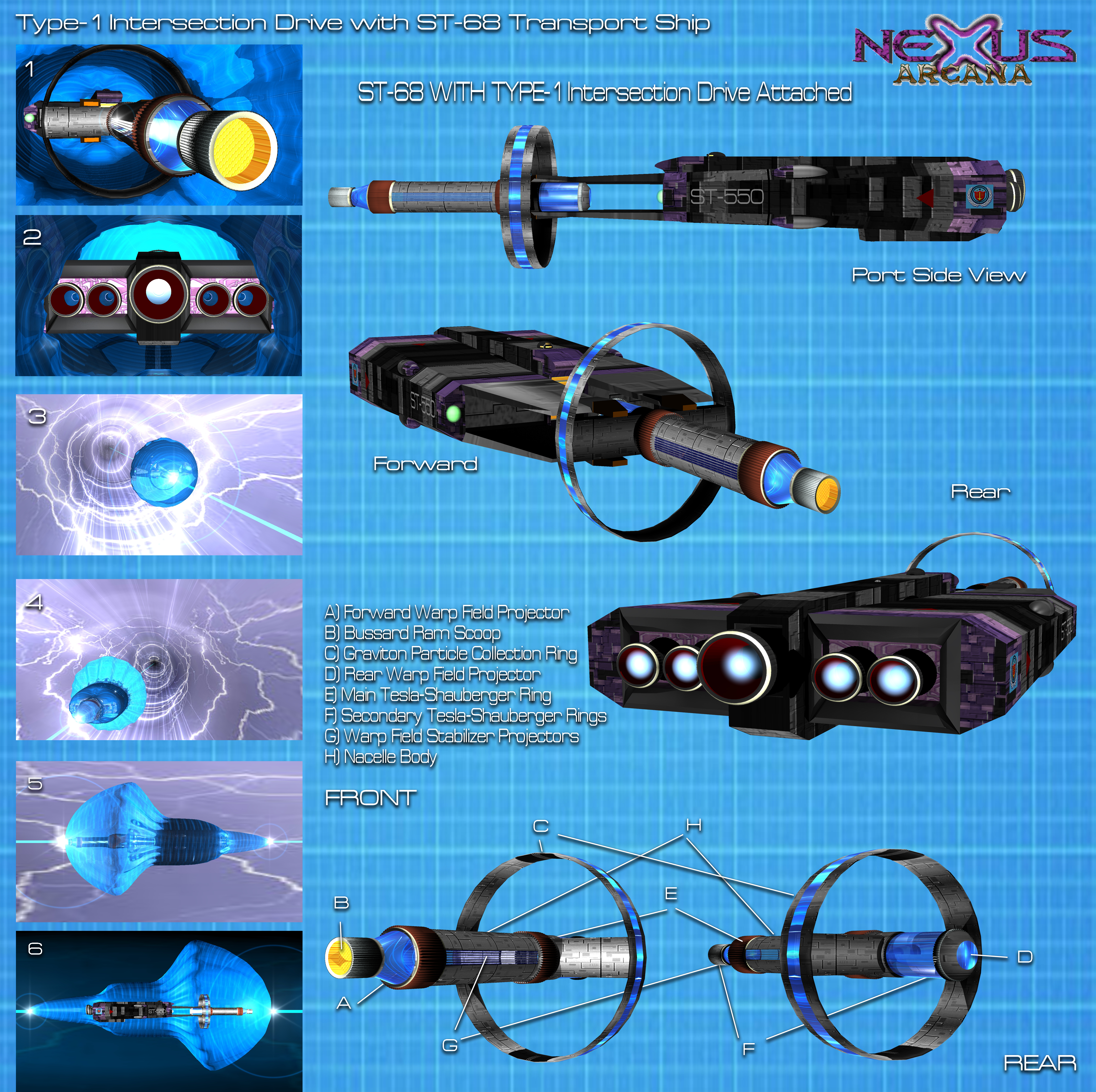 |
Prototype (Type-1) Intersection Drive:
The first type of Faster-Than-Light drive created by Terrans was the Type-1 Intersection Drive system. The Type-1 was more of a test-bed for the Type-2 than an actual production drive system. Only a handful of Type-1 drives were actually constructed by a joint LaGrange-USSN-UNSC group of conspirators who saw the discovery of the alien wrecks around the LaGrange colonies and the other planets of the solar system to be a threat rather than just the bones of an extinct galactic civilization. The test craft the Type-1 was built to use was the United Nations Space Corps ST-68 transport ship. Even though the USSN was at war with the Solar Empire, the UNSC and the LaGrange Republics had an amicable relationship despite their space forces continuing to wage combat with one another on various occasions due to spill over from the USSN-Solar Empire conflict of the 2060s. Even with hostilities between them, a cadre of individuals within these stellar nations pulled their resources together and used what they could of the alien technology to cobble together the first FTL drive system.
Type-1 Intersection Drive: The Type-1 drive works on the principle of punching a hole through the space-time continuum by using the intersection of natural cosmic electro-element lines of force (Dark Energy) near a planetary or stellar body of considerable size. The object must exert at least 1 g of gravity for the drive to work. The craft using the drive must follow the rotation of the planet or star within its gravity well and the ship must then accelerate around the stellar body with its rotation until the drive reaches breaking speed (maximum graviton particle collection, which is roughly a speed of 136,000 mph/218870.784 kph). The Type-1 drive does not require its own antigravity unit to be installed on the craft. Only one Type-1 engine may be mounted on a craft due to its horrible warp bubble geometry. The Type-1 was not considered safe enough for military applications, it was only useful for research and cursory exploration of nearby stars. Its warp bubble was so unstable that the gravition collection ring had to double as a warp field extender/stabilization booster to keep the bubble from collapsing onto the ST-68 test ship. The radiation from the drive did not damage the hull of spacecraft of the 2060s, but the discharge from coming out of warp was not directed away from the ship and thus any attempt to mount the engine internally was considered too dangerous/lethal. The original production run of Type-1s were all over 15,000 tons and nearly the size of an Anapolis class cruiser. While perfect for the UNSC transport ship (150,000 ton spacecraft) due to the electromagnetic grappling clamps on the vessel (which was normally used to hold UN shuttles and ferry the older UN nuclear engine craft throughout the solar system at high speed via the ST-68's high-yield-ion-engines), the Type-1 was impractical on any other spacecraft. What is significant about the Type-1 is that the first ST-68 to use it to go to Alpha Centauri, was the one that found the Prodono ship depot in orbit around one of that star system's inner planets. The time-dilation ("speed") of the TYpe-1 was a miserable 0.06 light years per hour, meaning that a trip to Alpha Centauri one way took 72.8 hours. While fast by the standards of the early and mid 21st Century, it was a crawl compared to the Type-2 drive which took half that time.
Key:
1) Inside shot of the warp bubble showing the Type-1 drive held firm by the jaws of the ST-68 cargo claws.
2) Inside shot of the rear of the ship showing the horrible warp bubble dynamics. The warp field nearly touches the ship, and the first two unmanned ST-68s used in the early testing of the drive were destroyed prior to engineers tweaking the computations of the drive to get it to work.
3) Outside view of the front of the warp bubble showing the almost perfect first quarter of the warp field emanating from the forward emitter. This view also shows the hyperspace tunnel the ship is traveling to on its way to Alpha Centauri.
4) Rear view of the warp bubble showing the terrible geometry of the warp field after it passes over the hull of the ST-68 and begins to collapse almost immediately.
5) Side view of the warp bubble showing the electro-element line of force the bubble is riding like a cable-car.
6) Side view showing the ship inside the bubble and illustrating just how close the warp field comes to the hull, though it does not touch it. |
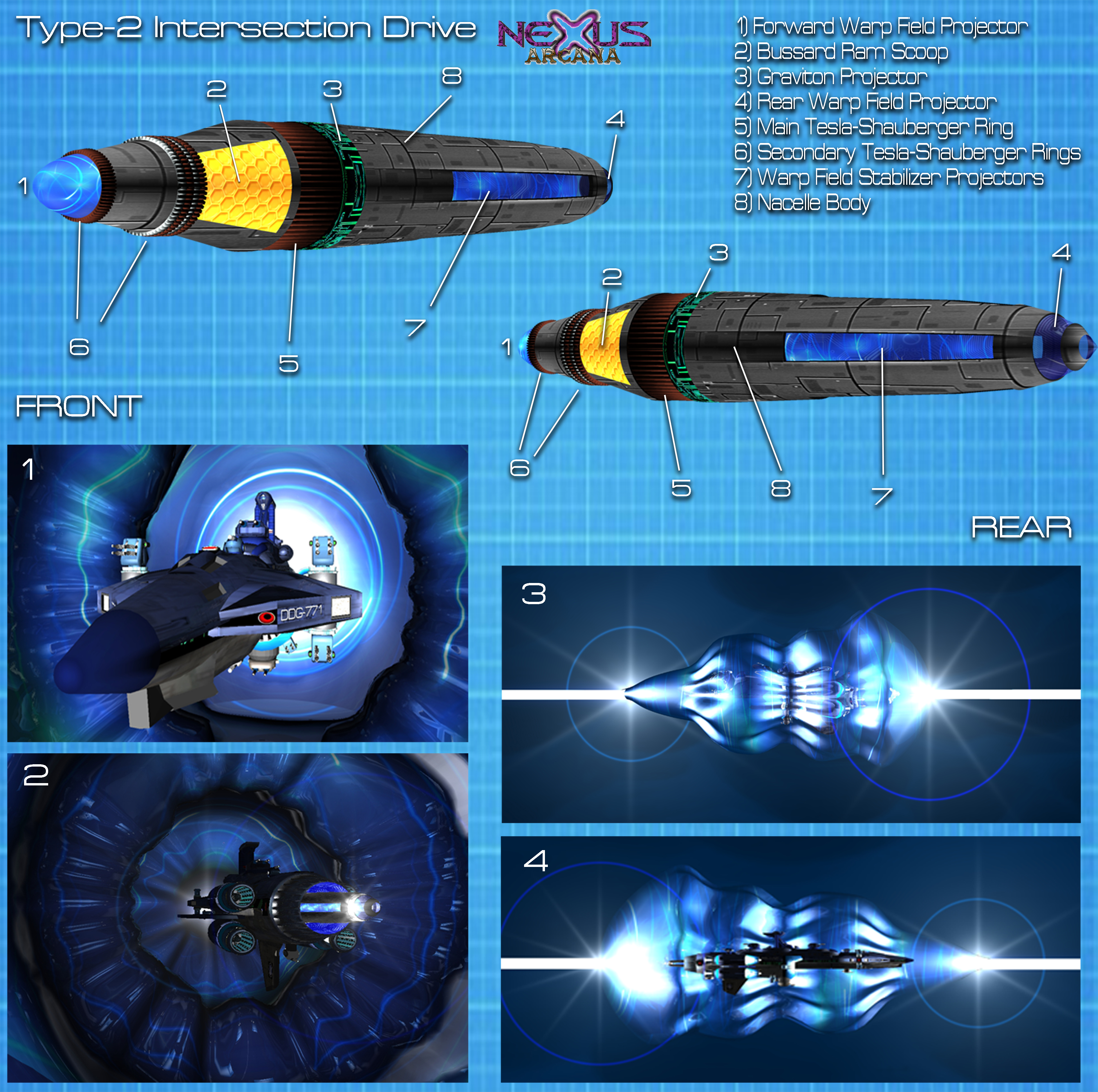 |
Type-2 Intersection Drive (Production model):
Intersection Drive Technology: This technology is a hybrid of Terran concepts of FTL physics and the Prodono Super-Dimensional Energy physics discovered amongst the alien derelicts, ruins, and other artifacts throughout the solar system.
Type-2 Intersection Drive: The second type of intersection drive, the Type-2 engine, is able to generate its own gravity well by using the antigravity system of the vessel it is installed on as a graviton projector. The Type-2 intersection drive creates a warp bubble around the spacecraft which pulls and pushes the ship along the cosmic electro-element lines of force at FTL velocity. The Type-2 drive is considerably faster than the Type-1. Up to three Type-2 intersection drives may be mounted on a craft. However, each drive requires its own antigravity unit, so a craft with two or three Type-2 drives will require either two or three antigravity units respectively plus an additional computer for each drive unit above one. The time-dilation ("speed") of this engine is .12 light years per hour, making it twice as "fast" as the Type-1. However, the whole family of Intersection Drive types generate a very unstable warp field that limits the time-dilation greatly. Contrast the "speed" of this Juno-Mark-II with that of a Prodono warship using a Hyperspace Fold Flight System that has a time-dilation of 10 light years per hour, and one can clearly see how primitive the Intersection Drive is in comparison. Ideally a drive should form an egg shaped or pear shaped warp field around a craft to allow a more stable warp bubble. The Type-2 was far more stable than the Type-1, but very unstable compared to the alien technology it was developed from.
The Type-2 was the most common FTL type engine of the late 21st Century and was based almost entirely on the UNSC/Solar Empire engines of their Iron Clads built late in the 1st Interplanetary War. While FTL didn't help the Solar Empire in the war, it's introduction did allow the fledgling solar nations of Sol to spread out into the local group of stars and begin colonization efforts in the 2080s and 90s.
The example shown in the image is that of a Earth Federal Republic produced drive by the Warptron company of the LaGrange Colonies. The ship shown is a Juno-Mark-II FTL capable spacecraft. Most of the EFR's space navy was refit during the 2080s (after the Ceres Conflict) over to FTL capability using the existing (and most common) Intersection Drive systems available. While Stellar Warp Drives were available at the time (a different approach to FTL based on the Type-1 Intersection Drive unit), the existing Solar Empire facilities on Mars and Venus were in EFR hands, and thus manufacturing the Intersection Drive was a more practical course of action for them to upgrade their existing fleet of spacecraft during the mid-2080s.
1) A forward view of the Juno-Mark-II within the graviton-warp bubble generated by the drive. Note that the bubble's "skin" does not touch the ship anywhere. If it did it would destroy the vessel instantaneously.
2) Rear view of the Juno-Mark-II and its Type-2 Intersection Drive unit generating the warp bubble.
3) An "outside" view of the inferior warp bubble of the Type-2 Intersection Drive and the electro-element conduit it is "riding" along through hyperspace.
4) A cutaway view showing the Juno inside the warp bubble. Notice how the warp field collapses as it gets to the front of the vessel's gravitational field.
These drives were used by the Ceres Regency, Grand Duchy of Ceres, the Solar Empire, and the Earth Federal Republic. The Jovian Defense Forces, and Union of Solar Republics use Stellar Warp Drive technology which is a technological variation of the Type-2 Intersection Drive.
|
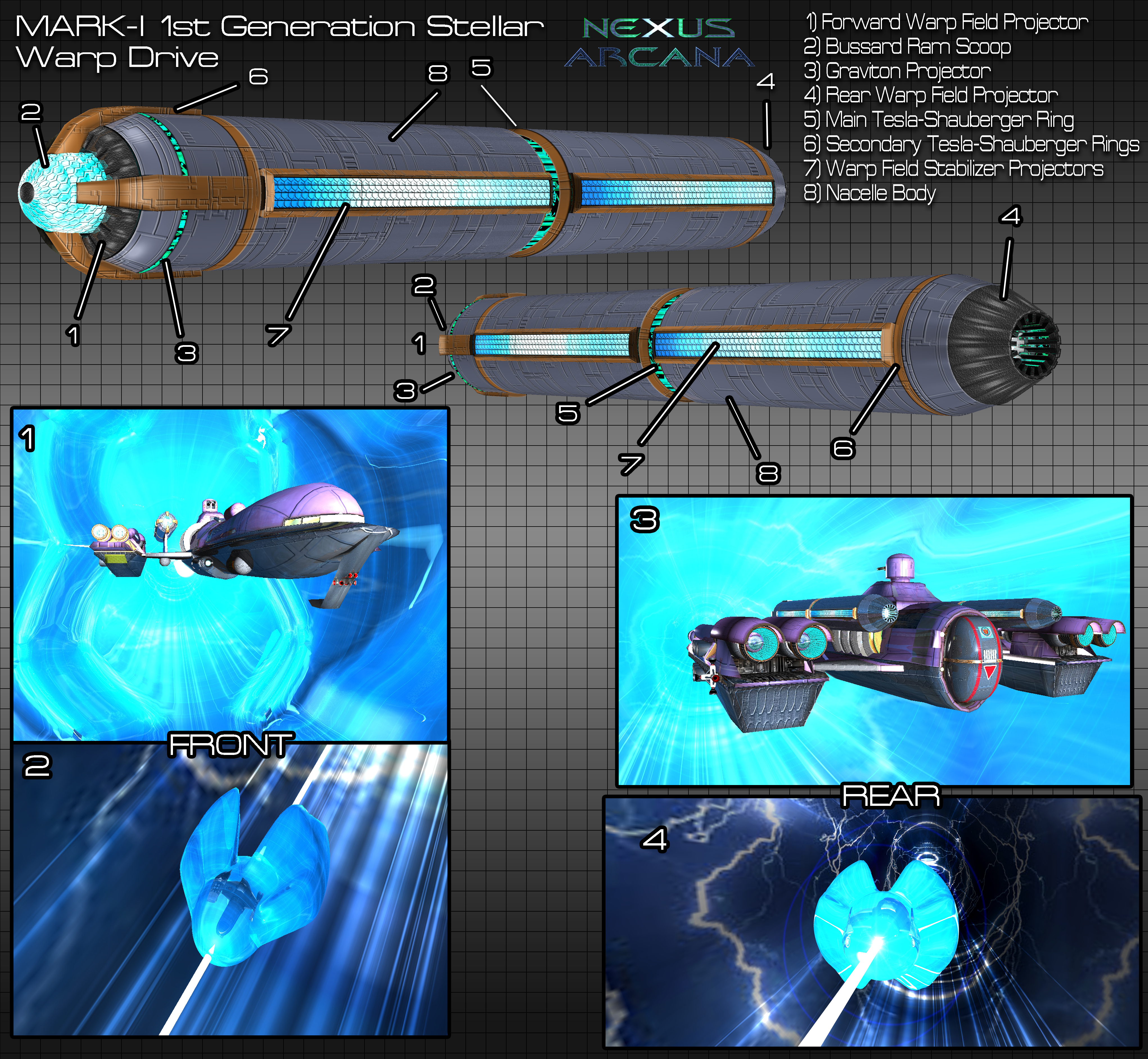 |
1st Generation Stellar Warp Drive :
Stellar Warp Drive Technology: This technology is derived purely from the Prodono version of the stellar warp drive physics discovered amongst the alien derelicts, ruins, and other artifacts throughout the solar system. With most of the technology coming from the L4-2035 object discovered near the Earth-moon L4 Lagrangian point by a LaGrange Republics Type-35 Patrol shuttle.
1st Generation Stellar Warp Drive: The first generation of Terran built stellar warp drive engine is able to generate its own gravity well by using the antigravity system of the vessel it is installed on as a graviton projector. The MARK-I SWD creates a warp bubble around the spacecraft which pulls and pushes the ship along the cosmic electro-element lines of force at FTL velocity. The MARK-I drive is considerably slower than the Type-1 Intersection Drive unit. However, the 1st Generation of SWDs were capable of being used in configurations of one, two, three, or even four nacelles. This allowed the time-dilation speed of the drive to increase. In the case of the MARK-I, the time-dilation was .038 light years per hour per warp nacelle. Unlike the Intersection Drives, the Stellar Warp Drive does not require its own antigravity unit for each drive mounted on the vessel since each nacelle is its own graviton generator. Therefore, a craft with two, three, or even four SWD nacelles still only requires one antigravity unit. Another major improvement over the Intersection Drive was the SWD's stable warp field. Ideally a drive should form an egg shaped or pear shaped warp field around a craft to allow a more stable warp bubble. The 1st Generation of Stellar Warp Drive did make a very uniform field, although, human error and lack of experience with super-dimensional energy physics caused the MARK-I drive to produce "wings" that flared out behind the ship's warp bubble. This waste of energy greatly reduced the effectiveness of the field and thus caused a slower than optimum speed to be generated.
The 1st Generation Mark-I SWDs were most commonly used on the UNSC/Solar Empire AS-04 assault shuttles during the 1st Interplanetary War period. While FTL didn't help the Solar Empire in the war, it's introduction did allow the fledgling solar nations of Sol to spread out into the local group of stars and begin colonization efforts in the 2080s and 90s.
The example shown in the image is that of a UN Space Corps Mark-I produced drive by the Cydonia Research facility on the UNSC base of the planetoid Pallas. The ship shown is an AS-04 FTL capable spacecraft.
1) A forward view of the AS-4 within the graviton-warp bubble generated by the drive. Note that the bubble's "skin" does not touch the ship anywhere. If it did it would destroy the vessel instantaneously.
2) Top "outside" view of the AS-04 generating the warp bubble and riding the super-dimensional energy "Ley Lines" through hyperspace.
3) Rear view of the AS-04 inside the warp bubble of the SWD engines.
4) Forward view of the AS-04, showing the flare of the wings as the line of super-dimensional energy passes around the warp bubble.
These drives were used by the Jovian Defense Forces, and Union of Solar Republics. |
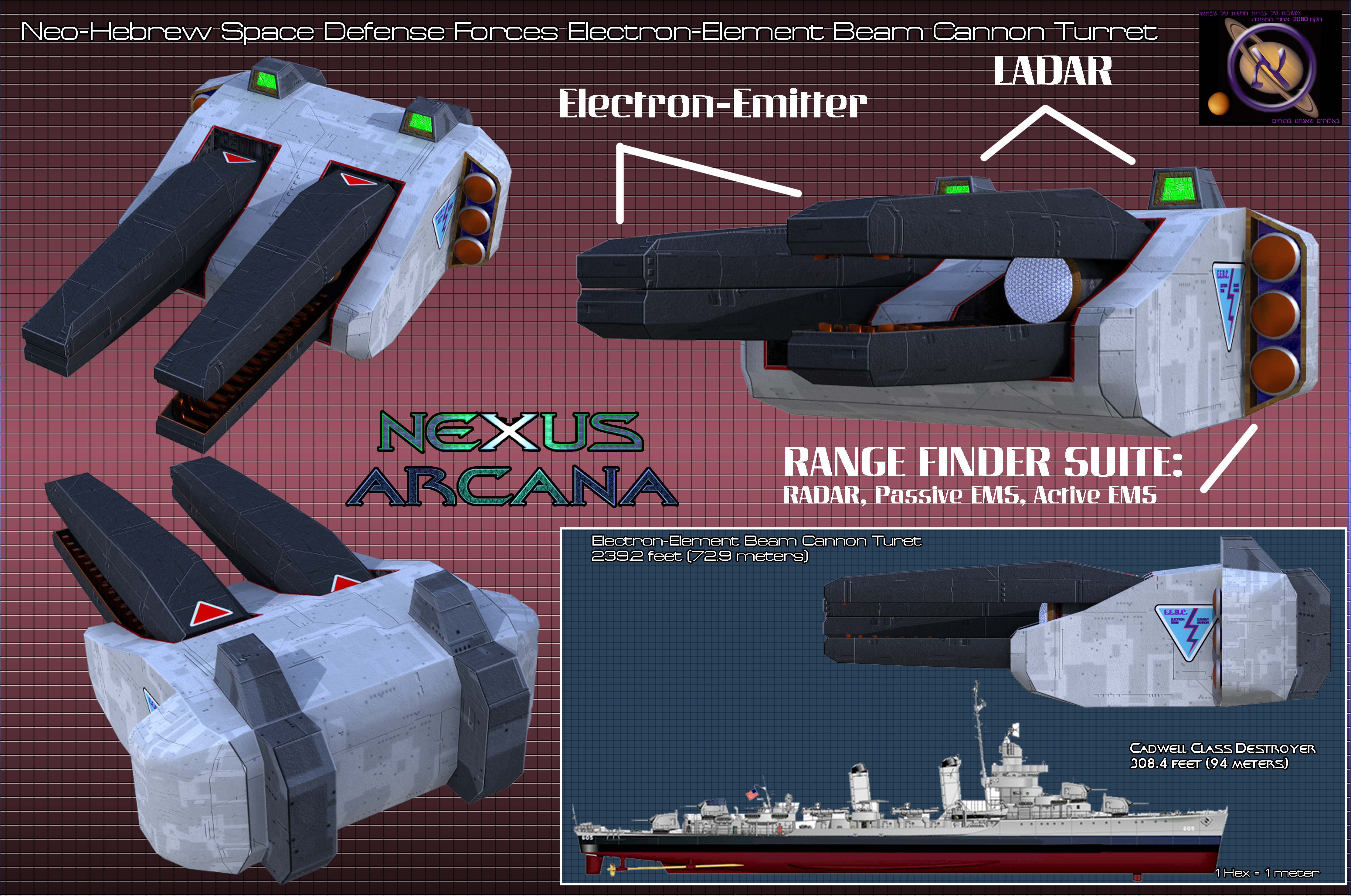 |
Electron Element Beam Cannon Turret:
Detail of the main turrets of the massive Titan Class Space Control Ship of the Neo-Hebrews of Saturn.
This turret has a pair of EEBCs.
Left Emitter is in the open position showing the electron-generator dish and electro-gravitic compression rails (top and bottom of emitter case).
The destructive power of the beam is 60,000 Terajoules (14.35 megatons of TNT) each emitter for a total of 129,000 Terajoules (28.7 megatons) of destructive force.
There is a down-sized, dual-5000-megawatt, version of this turret also mounted on the Titan Class.
I may add that one to this image later. |
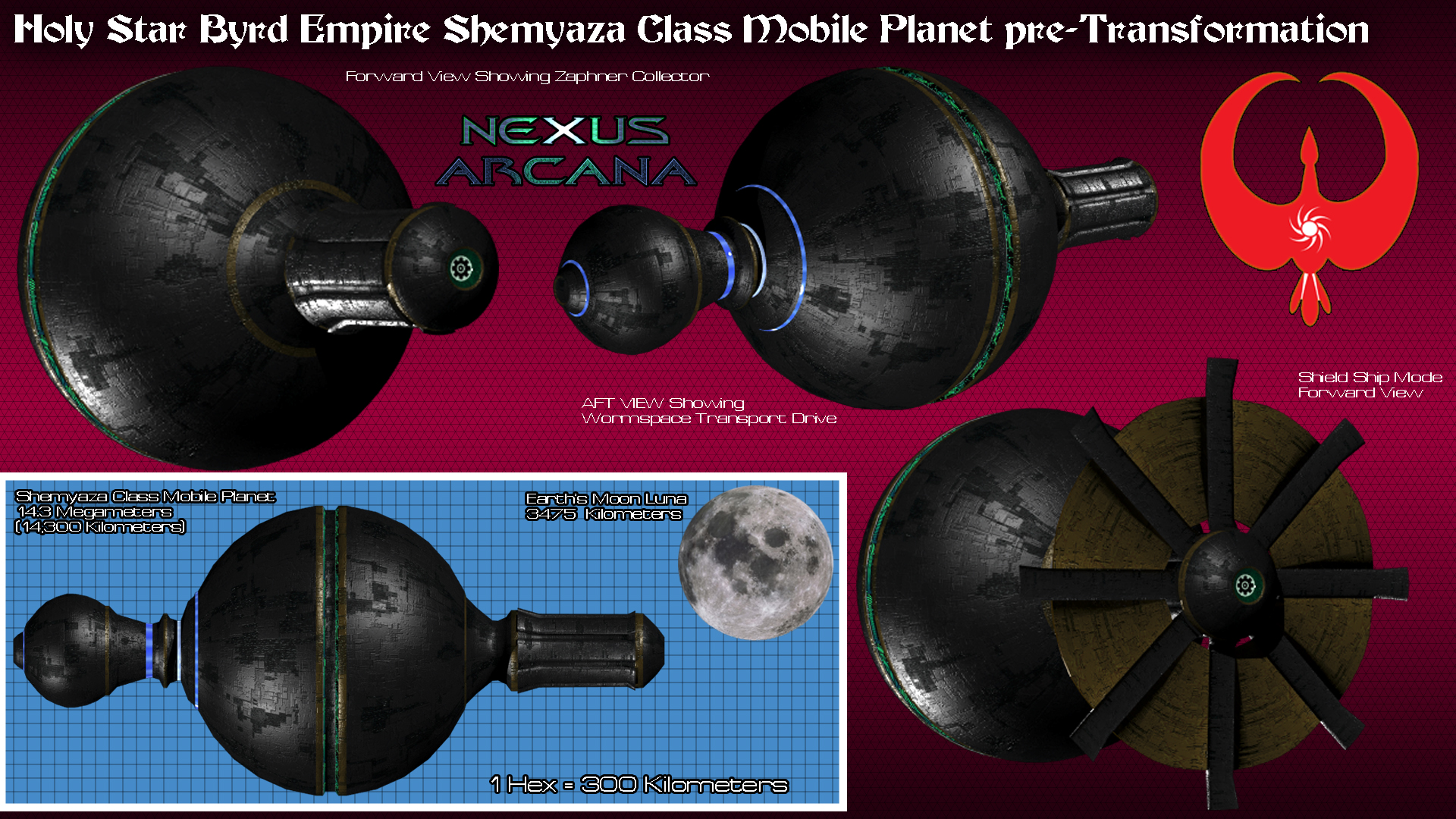 |
Shemyaza Pre-Transformation:
Built sometime around 445,000 BC, the Shemyaza was Daelthaneous' ultimate terror weapon.
Little is known about this monstrosity, save that this was its pre-transformation state that allowed it to travel around the galaxy.
It is seen in Book 5 "Godahkeen" of the Nexus Arcana series.
|
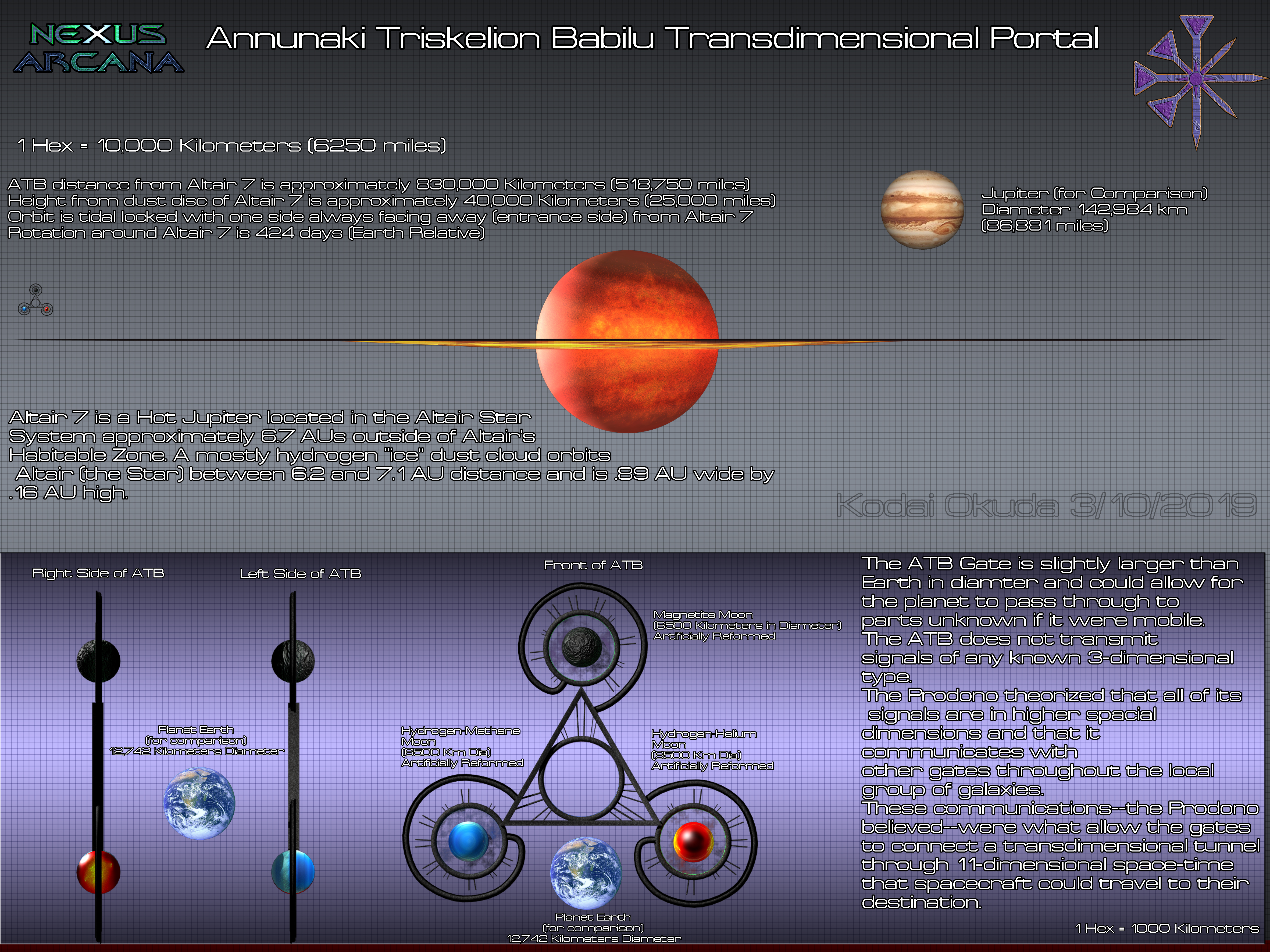 |
Annunaki Triskelion Babilu:
Estimated to have been built over 36,000,000 Earth Years ago by the ancient race dubbed the Annunaki by reseachers, the Annunaki Triskelion Babilu (ATB) is one of the alien wonders of the local group of stars around Sol (all stars within 100-light years). Located in the Altair star system some 16.7 lights years from Sol, around the Hot Jupiter Altair-7, the ATB is not a star gate in the traditional sense of the idea (an Einstein–Rosen Bridge), but rather a trans-dimensional gateway into 11-dimensional space that allows for riding the "cosmic ley line highway" from one of these ATBs to another in the universe at super-dimensional time dilations (estimated to be 10,000 light years per hour time dilation). These structures appear to use Dymaxion-like architecture first proposed by Buckminster Fuller combined with both the Fibonacci Sequence and "divine" geometric concepts, to scale up the gravitic distortion of a nearby large stellar body (in the case of the Altair-7 ATB, a Hot Jupiter pre-star and three of its moons: 1 moon in each of the "arms" of the Triskelion) and allow for entrance into a stable tunnel through 11D space.
The method of operating this device is completely unknown and only by using the Prodono data on the ATB from a nearly Goro Dei class battlefactory was it discovered that this ATB is connected to many others, some of which are in the Magellanic Clouds and even the Andromeda galaxy. The Prodono information found at the abandoned Goro Dei class battlefactory in Altair (the second one found near the Sol star system the first being in Alpha Centauri) was inconclusive and gave only cursory data on the object.
It should be noted that Altair-7 is an unusual Hot Jupiter in that is is not close to its parent star (like many Hot Jupiters) and it is within a large dust cloud that continually feeds the pre-star with new material. This generates an immense electromagnetic field that is believed to be the power source of the ATB's non-gate functions (life support, lighting, internal devices, etc.)
The ATB is 61,300 kilometers (38,090 miles) wide and tall. The central gate ring is 13,000 kilometers (8077.9 miles) in diameter.
|

